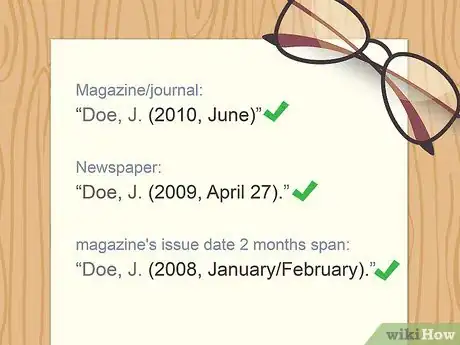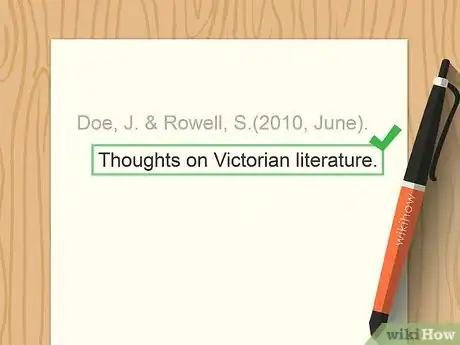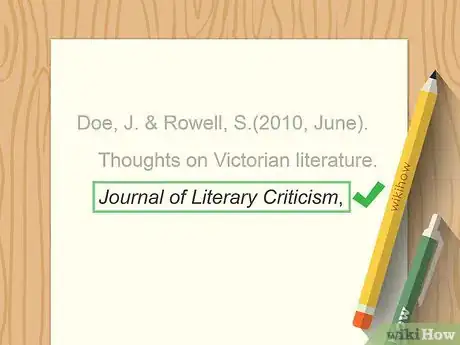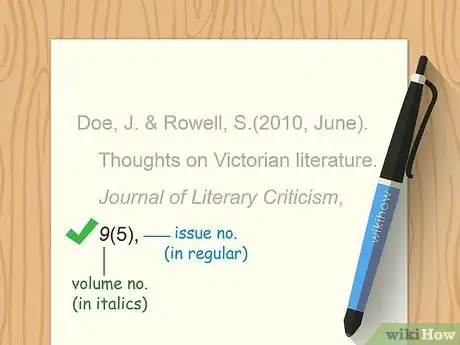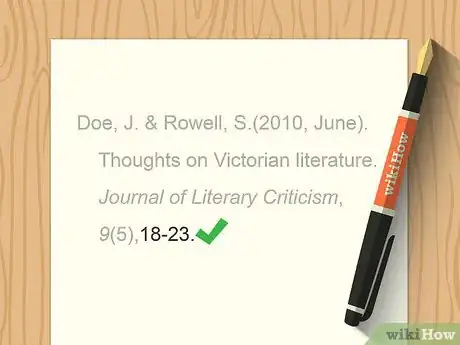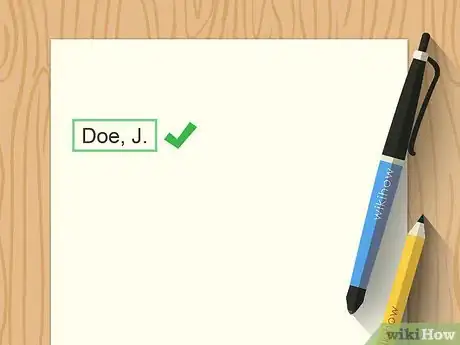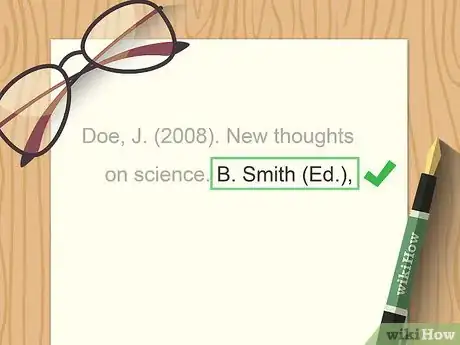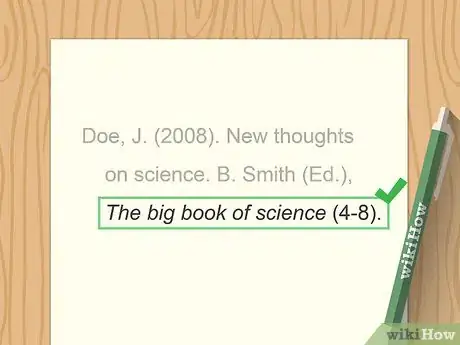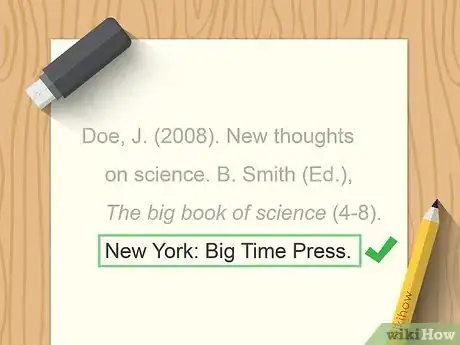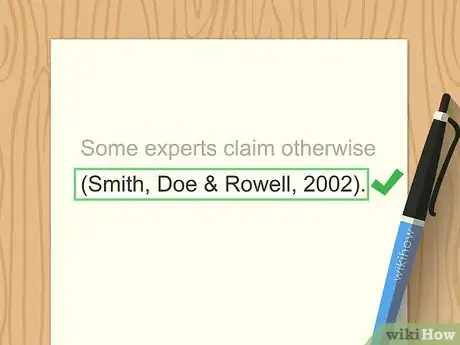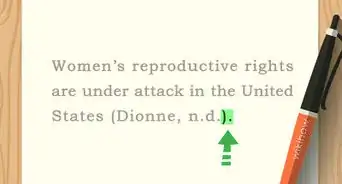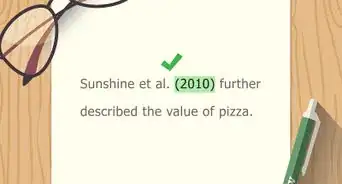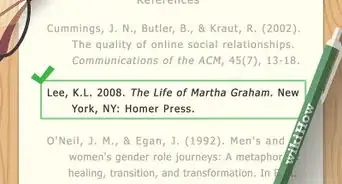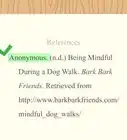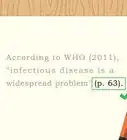This article was co-authored by wikiHow staff writer, Jennifer Mueller, JD. Jennifer Mueller is a wikiHow Content Creator. She specializes in reviewing, fact-checking, and evaluating wikiHow's content to ensure thoroughness and accuracy. Jennifer holds a JD from Indiana University Maurer School of Law in 2006.
This article has been viewed 86,519 times.
Learn more...
Papers and reports written in the social sciences most often use the American Psychological Association (APA) citation style. All sources you reference in your paper or report are listed in a reference list at the end of your paper, in alphabetical order by the last name of the author. The author's name and the year of publication is used in-text to refer the reader to the appropriate entry in the reference list.[1]
Steps
Citation Templates and Sample Citations
Citing Magazine, Journal, and Newspaper Articles
-
1Start with the author's name. List the author's name with the last name first, followed by a comma, then the author's first and middle initials (if the middle initial is available). If the article has more than 1 author, list them in the order they appear in the by-line of the article. Separate the names of 2 authors with an ampersand. For 3 or more authors, use commas between names and an ampersand before the final name.[2]
- Example with 1 author: "Doe, J."
- Example with 2 authors: "Doe, J. & Smith, A. B."
- Example with multiple authors: "Doe, J., Smith, A. B., & Johnson, K."
-
2Add the publication date for the journal, magazine, or newspaper. After the last author's initial, type a space, and then open parentheses. Type the publication date using year-month-day format, without any abbreviations.For most magazines and journals, you will only have the month and the year of publication. For a newspaper, you will usually have the specific date. Close your parentheses and place a period immediately after.[3]
- Magazine/journal example: "Doe, J. (2010, June)."
- Newspaper example: "Hoffman, D. & Rowell, S. (2009, April 27)."
- If a journal or magazine's issue date spans 2 months, include both months. For example: "Doe, J. & Smith, A. B. (2008, January/February)."
Advertisement -
3Type the title of the article. After the date, include the full title of the article in sentence-case, capitalizing only the first word and any proper nouns. If the article has a subtitle, place a colon at the end of the title and include the subtitle, capitalizing only the first word after the colon and any proper nouns. Place a period at the end of the title.[4]
- Example: "Doe, J. (2010, June). Thoughts on Victorian literature."
-
4Include the title of the journal, magazine, or newspaper in italics. Immediately after the title of the article, type the title of the publication in which the article appeared. As with the article title, use sentence-case, capitalizing only the first word and any proper nouns. Follow with a comma.[5]
- Example: "Doe, J. (2010, June). Thoughts on Victorian literature. Journal of Literary Criticism,
-
5Provide the volume and issue number, if applicable. Academic journals in particular typically have volume and issue numbers. Type a space, then put the volume number in italics after the title of the publication. Follow with the issue number in parentheses. The issue number should not be in italics. Place a comma after the volume or issue number.[6]
- Example: "Doe, J. (2010, June). Thoughts on Victorian literature. Journal of Literary Criticism, 9(5),"
- If no issue number is available, do not leave a space for it. For example: "Doe, J. & Smith, A. B. (2008, January/February). Newest Tech Gadgets. Popular Computer Magazine, 3,"
-
6Specify the page numbers where the article can be found. Type a single space after the comma, then type the page numbers where the article starts and ends, separated by a hyphen. If the pages are non-sequential, place a comma between the spaces. For newspaper articles, use the abbreviation "p." for a single page, or "pp." for multiple pages.[7]
- Example with sequential pages: "Doe, J. (2010, June). Thoughts on Victorian literature. Journal of Literary Criticism, 9(5), 18-23."
- Example with non-sequential pages: "Hoffman, D. & Rowell, S. (2009, April 27). State of the economy. Fort Wayne News, pp. A1, A10."
-
7Include the DOI or URL for online articles. Most scholarly journals have a digital object identifier (DOI) that provides a static online reference number for that article. Use this number if one is available. Otherwise, type the phrase "Retrieved from" followed by the full permanent URL for the article.[8]
- DOI example: "Brownlie, D. (2007). Toward effective poster presentations: An annotated bibliography. European Journal of Marketing, 41, 1245-1283. doi:10.1108/03090560710821161"
- URL example: "Kenneth, I. A. (2000). A Buddhist response to the nature of human rights. Journal of Buddhist Ethics, 8. Retrieved from http://www.cac.psu.edu/jbe/twocont.html.
Articles from Edited Books
-
1Start with the author of the article. Provide the last name of the author of the article, followed by a comma and the author's first and middle initials. If the article has 2 authors, separate their names with an ampersand. Separate the names of multiple authors with commas, using an ampersand before the final author's name.[9]
- Example with 1 author: "Doe, J."
- Example with multiple authors: "Smith, S. J., Keller, J. H. & Dalton, U."
- If there are multiple authors, list them in the same order as their names appear in the by-line for the article.
-
2Provide the year the book was published in parentheses. Look on the title page of the book to find the year the book was published. Always use the year the book was published, even if the article was previously published somewhere else. Follow the parentheses with a period.[10]
- Example: "Doe, J. (2008)."
-
3Write the title of the article. After the year of publication, type the title of the article in sentence-case, capitalizing only the first word and any proper nouns. If the article has a subtitle, include it after a colon. Any subtitle should also be in sentence-case, capitalizing the first word after the colon and any proper nouns. End the sentence with a period.[11]
- Example: "Doe, J. (2008). New thoughts on science."
-
4List the editor of the book. Put the editor's initials first, followed by their last name. Separate the names of multiple editors with commas (ampersand before the last), listing them in the same order as they appear on the title page. Follow with the appropriate abbreviation (Ed. or Eds.) in parentheses, then close with a comma.[12]
- Example with 1 editor: "Doe, J. (2008). New thoughts on science. B. Smith (Ed.),"
- Example with multiple editors: "Smith, S. J., Keller, J. H., & Dalton, U. (2010). Computer technology trends. B. Smith & Y. Joyce (Eds.),"
-
5Include the title of the book with page numbers. Following the comma, type the title of the book in sentence-case. The title of the book should be italicized. After the title of the book, place in parentheses the page numbers where the article can be found. The page numbers should not be italicized. Close with a period.[13]
- Example: "Doe, J. (2008). New thoughts on science. B. Smith (Ed.), The big book of science (104-118)."
-
6Close with the location and name of the book's publisher. If the book was published in the United States, include the name of the city and the postal abbreviation for the state, separated by a comma. For a book published in any other country, use the name of the city and the name of the country. Place a colon, then write the name of the publication company.[14]
- Example: "Doe, J. (2008). New thoughts on science. B. Smith (Ed.), The big book of science (104-118). New York: Big Time Press."
Creating in-Text Citations for Articles
-
1Use author-date parenthetical citations in text. When you write a sentence that includes a fact or statement you derived from the source, place a parenthetical citation at the end of that sentence with the last name of the author and the year the article was published.[15]
- Example: "(Doe, 2008)."
- If there are multiple authors, separate with colons and an ampersand before the final author's name. For example: "(Wegener & Petty, 1994)."
- For more than 2 authors, list all authors in your first in-text citation. In any subsequent citations, list the first author's last name only, followed by the abbreviation "et al." For example, if your first in-text citation was "(Doe, Smith, Petty, & Walsh, 2014)," subsequent citations would be "(Doe et. al., 2014)."
- If you mention the author's name directly in the text of your paper, simply include the year of publication in parentheses immediately after the author's name. For example: "As Doe (2008) found, scientific methods have changed over time."
-
2Separate multiple citations with a semi-colon. In writing your paper, you may find that a particular fact or statement is supported by multiple sources. List all sources where the fact can be found in the same parenthetical, separated by semi-colons.[16]
- Example: "(Doe, 2008; Worcester, 2011)."
-
3Capitalize titles mentioned in the text of your paper. In the text of your paper, use title-case for any article titles, capitalizing all words that are more than 4 letters long. Enclose the title of an article in quotation marks.[17]
- Example: "As Doe (2008) noted in "New Thoughts on Science," methods of scientific discovery are increasingly subject to backlash."
-
4Include the page number after quotations. Any time you quote from a source directly, list the page number where that quote can be found in your parenthetical citation to the source. The in-text citation should also include the author's name and year of publication. Put your citation outside the quote marks immediately after the quote.[18]
- Example: "(Doe, 2008, p. 47)."
Community Q&A
-
QuestionWhere do I write the reference of an essay?
 Tom De BackerTop AnswererEvery time you cite someone else's work, put a mark (usually a number) in superscript immediately after that reference in your own text. Write a separate chapter called Bibliography all the way at the end, where you list all the works you have cited according to the standard bibliography rules.
Tom De BackerTop AnswererEvery time you cite someone else's work, put a mark (usually a number) in superscript immediately after that reference in your own text. Write a separate chapter called Bibliography all the way at the end, where you list all the works you have cited according to the standard bibliography rules. -
QuestionWhat if the author's name is unknown?
 Tom De BackerTop AnswererIn the reference, where the name of the author would go, write "[author unknown]".
Tom De BackerTop AnswererIn the reference, where the name of the author would go, write "[author unknown]".
References
- ↑ https://owl.english.purdue.edu/owl/resource/560/10/
- ↑ https://courses.semo.edu/library/infolit/apastyle_articles.htm
- ↑ https://courses.semo.edu/library/infolit/apastyle_articles.htm
- ↑ https://courses.semo.edu/library/infolit/apastyle_articles.htm
- ↑ https://courses.semo.edu/library/infolit/apastyle_articles.htm
- ↑ https://courses.semo.edu/library/infolit/apastyle_articles.htm
- ↑ https://courses.semo.edu/library/infolit/apastyle_articles.htm
- ↑ https://owl.english.purdue.edu/owl/resource/560/10/
- ↑ http://guides.libraries.psu.edu/apaquickguide/books
- ↑ http://guides.libraries.psu.edu/apaquickguide/books
- ↑ http://guides.libraries.psu.edu/apaquickguide/books
- ↑ http://guides.libraries.psu.edu/apaquickguide/books
- ↑ http://guides.libraries.psu.edu/apaquickguide/books
- ↑ http://guides.libraries.psu.edu/apaquickguide/books
- ↑ https://owl.english.purdue.edu/owl/resource/560/03/
- ↑ https://owl.english.purdue.edu/owl/resource/560/03/
- ↑ https://owl.english.purdue.edu/owl/resource/560/02/
- ↑ https://owl.english.purdue.edu/owl/resource/560/03/
About This Article
To cite an article using APA citation style, start with the author’s last name first, followed by a comma, then their first and middle initials. If the article has more than 1 author, list them in the order they appear in the byline of the article. Next, in parentheses, add the publication date starting with the year, then the month, and, if applicable, the day. Then, include the title of the article, the title of the publication in which the article appeared, and the volume and issue number, if available. Finally, specify the page numbers where the article can be found. To learn how to create in-text citations for articles, keep reading!


